Generality
Minestrone is an extremely widespread recipe throughout the Italian peninsula; it is a low energy first course, therefore suitable for the diet against overweight; furthermore, due to its nutritional characteristics, it facilitates the treatment of many pathological conditions or simple disorders.

Minestrone is considered a soup, or a soupy first course, as it brings a concentration of water that fluctuates (approximately) between 75 and 90% of the total volume. It can be very "light" (if composed only of stem, leaf and fruit vegetables), medium caloric (if enriched with legumes and tubers) or more energetic (if it contains cereals and / or oil and / or cheese) .
Ingredients
As anticipated, the minestrone can have very different shapes, colors, textures and flavors. This is an EXTREMELY sensitive preparation for changes in season and territory, as the availability of vegetables changes significantly between summer and winter, or between the north and midday.
There is no soup that is better than the other, but different recipes; it goes without saying that, as for the other culinary preparations, this is also of higher quality if only FRESH ingredients are used. However, let's not forget that it is ALWAYS better "a good frozen soup", compared to a "mediocre canned".
We carefully analyze all the ingredients of the minestrone:
- Vegetables or leafy vegetables for minestrone: chard, dandelion, turnip leaf, chicory, cabbage, spinach, lamb's lettuce, cabbage (optional or questionable: celery leaves, green or red radicchio, endive, lettuce, rocket etc.)
- Vegetables or flower and fruit vegetables for minestrone: broccoli, cauliflower, artichoke, broccoli, tomato, courgette, pumpkin (optional or questionable: pepper, aubergine, etc.)
- Vegetables and vegetables in stem and bulb for minestrone: asparagus, onion, leek, garlic, shallots, fennel, celery, etc.
- Root and tuber vegetables or vegetables for minestrone: carrot, turnip, potato, Jerusalem artichoke etc.
- Mushrooms for minestrone: most of the commercial ones; champignons, galletti, porcini, pleurotus, nails, pioppini etc. They also do not disappoint morels (morels, strictly to blanch and rinse), dry legs, covers (which must necessarily be separated the stem just picked) and so on.
- Legumes and pods for minestrone: ALL, preferably beans, peas, broad beans, lentils, chickpeas, snow peas and green beans
- Cereals and derivatives for minestrone: ALL the whole grains, preferably NOT peeled or glazed; spelled, spelled, barley, brown rice, whole wheat etc. It is common to add toasted bread made with golden bread in hot, salted and peppered oil
- Aromatic herbs and spices for minestrone: to taste; I suggest: basil, parsley, chives, rosemary, sage, oregano, thyme, marjoram, black pepper, etc.
- Dressing fats for minestrone: preferably delicate extra virgin olive oil; in the winter recipe it can be used with pork fat (lard, bacon fat, bacon fat, raw ham rind fat, etc.)
- Other ingredients for minestrone: grated parmesan, diced parmesan rinds, bacon or speck or bacon or other diced cold cuts (generally overdone).
Vegetable Soup Lightest
X Problems with video playback? Reload from YouTube Go to Video Page Go to Video Recipes Section Watch the video on youtubeMinestrone Recipes
Completely omitting the addition of cereals, derivatives and cured meats, below I offer 3 recipes (or better, 3 combinations) of fresh vegetables for the minestrone formulation:
- Spring minestrone recipe: extra virgin olive oil + garlic + leek (to be used in the sauce), asparagus, dandelion, artichoke stalks, broad bean, morchella, jackdaw, rocket, celery and parsley + chives (to be added at the end, freshly chopped ).
- Recipe of summer minestrone (to be consumed also at room temperature): extra virgin olive oil + white onion (to be used in sauté), borlotto bean, string bean, fennel, "peperone", courgette, tomato, aubergine, turnip and basil + oregano ( to be added at the end, chopped fresh).
Autumn minestrone recipe: extra virgin olive oil + onion + celery + carrot (to be used in sauté), mushrooms (all), cutting chicory, thistle, celery, spinach, pumpkin and sage + parsley (to be added at the end, freshly chopped ).Composition for 100g of Minestrone Soup in Hyposic Box Ready to Serve 
Nutritional values (per 100 g of edible portion)
Edible part 100% water 87.3g Protein 2.0g Prevailing amino acids - Limiting amino acid - Lipids TOT 0.7g Saturated fatty acids 0.14g Monounsaturated fatty acids 0.28g Polyunsaturated fatty acids 0.25g Cholesterol 0.0mg TOT Carbohydrates 9.0g Starch 6.9g Soluble sugars 2.1g Dietary fiber 2.4g Soluble fiber - g Insoluble fiber - g Power 48.1kcal Sodium 215.0mg Potassium 186.0mg Iron 0.70mg Football 20.0mg Phosphorus 34.0mg Thiamine 0.06mg Riboflavin 0.04mg Niacin 0.64mg Vitamin A 33.0RAE C vitamin 5.70mg Vitamin E 0.70mg - Winter minestrone recipe: chopped lard with rosemary (to be used in sauté), potato, broccoli, Jerusalem artichoke, cauliflower, chard, broccoli and turnip leaves, pleurotus, rosemary (to be added at the end but whole). Excellent integration of rehydrated dry legumes.
NB . For those who like to use the sauce, it is strictly necessary for it to be sautéed over a low heat and no pulses (which would tend to harden) are thrown into it. Furthermore, both bread croutons and grated cheese should be added only to the finished dish; on the other hand, the crusts (previously scratched by superficial wax) should follow the vegetables being cooked. Personally, when I use pancetta or other sausages to brown, once golden, I remove them from the fried mixture to incorporate them at the end.
Uses and Nutritional Characteristics
As mentioned in the introduction, minestrone is a dish that, in addition to being remarkably suited for the structuring of low-calorie diets, is more than useful in the treatment of certain disorders.
First, minestrone is an excellent recipe for controlling high blood pressure. If it is formulated without salt, being rich in water and potassium, it helps to structure the well-known diet against hypertension. Not only, given its richness in dietary fiber, minestrone is also very useful in the treatment of constipation and in improving the satiety stimulus. Finally (but not least), in addition to the modest glycemic load (variable according to the ingredients), the minestrone boasts a very low glycemic index which has a positive impact on the metabolism of the diabetic (type 2 mellitus).
Finally, let's remember that the vitamin profile of the minestrone is pretty good (especially A, C and E), even if after cooking it inevitably involves a reduction of thermolabile vitamins.




